Post by Bonobo on Oct 19, 2018 22:38:16 GMT 1
Here, types of Polish shepherds - baca and juhas
polandsite.proboards.com/post/35600/thread
Redyk articles on nice sites
www.lem.fm/the-end-of-ii-bieszczady-first-sheep-pasture-day-redyk-in-lemko-village-of-oslawica/
Redyk – it is a festival about herding flocks of sheep into the mountains, for pasturing (spring redyk) and bringing them back for winter (autumn redyk). The practice used to be common in the Carpathians and many customs accompanied it. Nowadays, it is necessary to remind the contemporary inhabitants of the Carpathians, who not shepherds any more, of it, and to restore it, at least in the form of a demonstrative event. During the autumn Bieszczady Redyk, the participants could take a bite of various types of cheese, visit a cheese farm and eat some local food. There were ethnobotanic workshops organized concerning herbs and other plants that grow on meadows, practical for use. Bow and arrow shooters from Sanok who attended the event presented the classical way of shooting. There were also quiz games, games and workshops for children organized, like making toys out of wool. Sounds of the trembita resonated all the time during the event and, as the final point, the Kapela Drewutnia ensemble performed.
linktopoland.com/en/shepherding-in-the-tatra-and-other-polish-mountains/
Pastoral customs, traditions, techniques and equipment came to the Polish mountains from the south. They were strongly influenced by Vlachs – nomadic people coming from the Balkan area, who in the early Middle Ages began centuries long pilgrimage to the north. Nomads assimilated with the inhabitants of the Carpathian range and taught them new skills. Pastoral way of life came upon a breeding ground – difficult natural conditions (harsh climate and poor soil) favoured more animal husbandry than cereal farming. Shepherding started to develop in the Tatra and other Polish mountains.
What did the traditional pastoral season look like?
Each owner wanted to send his sheep to the mountain pasture for summer. It would entail leaving the household for several months, what was impossible. Therefore the function of baca (the main shepherd) was established – a man to whom farmers entrusted their flocks for summer time grazing. Baca was choosing some helpers – younger shepherds and set off to the mountain pastures owned by the village. Walking to the pastures called redyk could last even several days, depending on how far from the mountains the village was located. On a pasturage shepherds lived in a wooden hut called bacówka. Apart from grazing they were protecting sheep from predators or getting lost and manufacturing products from sheep’s milk. The best known are three types of cheese – oscypek, bundz and bryndza. Grazing was terminated with autumn redyk – sheep descent from the mountains. It was a very solemn event, accompanied by singing and music. Then the main shepherd settled up with sheep owners and returned them their flocks. Children welcoming redyk were receiving little pieces of cheese in the shapes of animals. Many traditions and superstitions associated with the pastoral season come from a borderline between religion and pagan beliefs. They are subject of a number of ethnographic research nowadays.
What about shepherding in the Polish mountains today?
History of individual pastoral areas and its influence on contemporary sheep grazing caused diversification of shepherding in different regions of Poland. Idyllic view with sheep in the mountain pastures is not as common as it was in the past. Nevertheless we can still meet shepherds or even visit their huts while hiking on the mountain trails in Gorce, Beskids or Pieniny. In some areas (eg in the Bieszczady Mountains) the aim is to renew the tradition of pastoralism.
In the Tatra Mountains, where shepherding had been completely liquidated due to the nature conservation in the 70’s, it was decided to restore grazing. Decisive influence had cultural issues – perennial relationship between the highlanders and the Tatras and richness of traditions and customs as its effect. In 1981, shepherding returned in a form of so-called Cultural grazing of sheep and cattle in the Tatra Mountains. What does it mean? Under agreements with the Tatra National Park highlanders can graze sheep on some of the clearings. They must, however, obey several rules including speaking in a dialect, wearing the original highlander outfit, whether be assisted by traditional herding dogs – the Polish Tatra sheepdogs. The are many more requirements, but thanks to them we can learn more about old customs and try products prepared according to original recipes.
Extremely interesting event is the Carpathian Sheep Transhumance organized for the first time in 2013. It is an international project aimed at meeting people involved in shepherding across the whole Carpathian range linked together with an exchange of experiences. This is the traditional wander of shepherds and flocks through the mountain area of the Carpathian countries – Romania, Ukraine, Poland, Slovakia and Czech Republic. The trail is about 1,200 kilometers long (10-15 kilometers a day) and takes place between May and September. The wander is accompanied by various events.
Dusk, the day is slowly coming to the end. I hear the tinkling sound again… The sheep are coming back to the pen for the night.
avax.news/fact/Traditional_March_of_Highlanders_with_Flocks_of_Sheep_in_Poland.html
Traditional March of Highlanders with Flocks of Sheep in Poland
An owner holds his sheep that he found among a herd during "rozchod", which in local language means giving back sheep to owners, during autumn Redyk in Gron village, Tatra Mountains region of southern Poland October 7, 2015. (Photo by Kacper Pempel/Reuters)
An owner holds his sheep that he found among a herd during "rozchod", which in local language means giving back sheep to owners, during autumn Redyk in Gron village, Tatra Mountains region of southern Poland October 7, 2015. Redyk is a traditional, kilometres-long march of highlanders with flocks of sheep, which takes place twice a year: in the spring at the start of the grazing season, and in the autumn at season's end. Shepherds are paid by owners in sheep milk for looking after the flocks while they graze over the summer. The autumn redyk ends in festivities, as highlanders celebrate returning with the flocks from the grazing fields in the mountains. (Photo by Kacper Pempel/Reuters)
Shepherd herd sheep as they get home during autumn redyk in Gron, Tatra Mountains region of southern Poland, October 6, 2015. (Photo by Kacper Pempel/Reuters)
Owners look for their sheep among a herd during "rozchod", which in local language means giving back sheep to owners, during autumn Redyk in Gron village, Tatra Mountains region of southern Poland, October 7, 2015. (Photo by Kacper Pempel/Reuters)
Owners take out their sheep from a herd during "rozchod", which in local language means giving back sheep to owners, during autumn Redyk in Gron village, Tatra Mountains region of southern Poland, October 7, 2015. (Photo by Kacper Pempel/Reuters)
Shepherds walk with sheep through the village on their way home during autumn redyk in Gron, Tatra Mountains region of southern Poland, October 6, 2015. (Photo by Kacper Pempel/Reuters)
A car is trapped among sheep on their way home during autumn redyk in Gron village, Tatra Mountains region of southern Poland, October 6, 2015. (Photo by Kacper Pempel/Reuters)
Shepherds relax and eat pizzas as they take a break in their journey home with sheep during autumn redyk near Trybsz, Tatra Mountains region of southern Poland, October 6, 2015. (Photo by Kacper Pempel/Reuters)
Shepherds relax as they take a break in their journey home with sheep during autumn redyk near Trybsz, Tatra Mountains region of southern Poland, October 6, 2015. (Photo by Kacper Pempel/Reuters)
Shepherd Jan drinks vodka with others as they take a break in their journey home with sheep during autumn redyk near Trybsz, Tatra Mountains region of southern Poland, October 6, 2015. (Photo by Kacper Pempel/Reuters)
Around one thousand sheep are seen in the fog in the early morning during autumn redyk near Lapsze Wyzne village, Tatra Mountains region of southern Poland, October 6, 2015. (Photo by Kacper Pempel/Reuters)
Shepherds walk with sheep in the early morning during autumn redyk near Lapsze Wyzne village, Tatra Mountains region of southern Poland, October 6, 2015. (Photo by Kacper Pempel/Reuters)
Shepherds and sheep cross a bridge while on their way home during autumn redyk near Trybsz, Tatra Mountains region of southern Poland, October 6, 2015. (Photo by Kacper Pempel/Reuters)


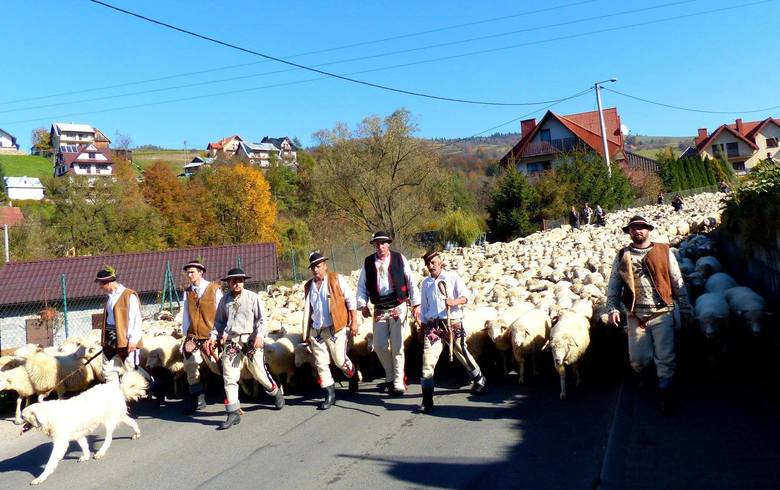

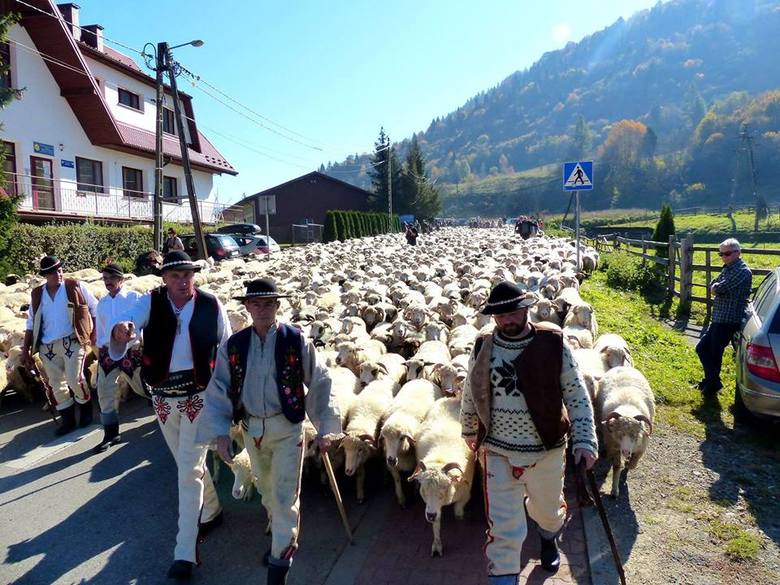

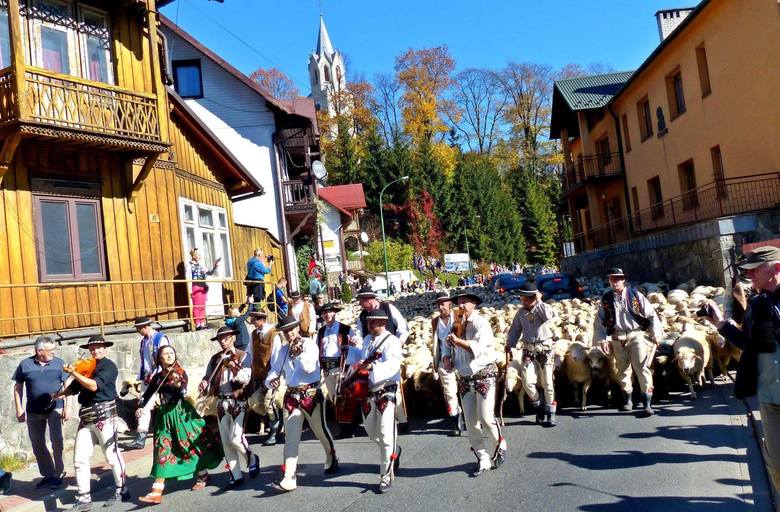
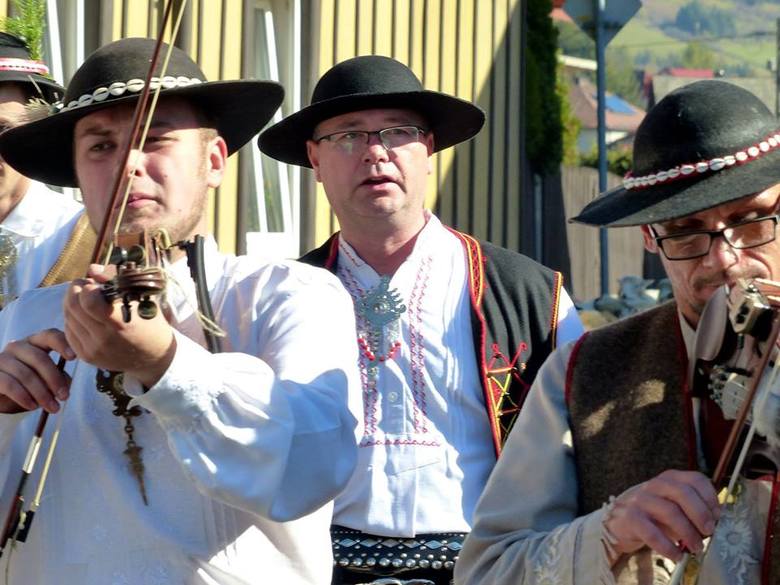
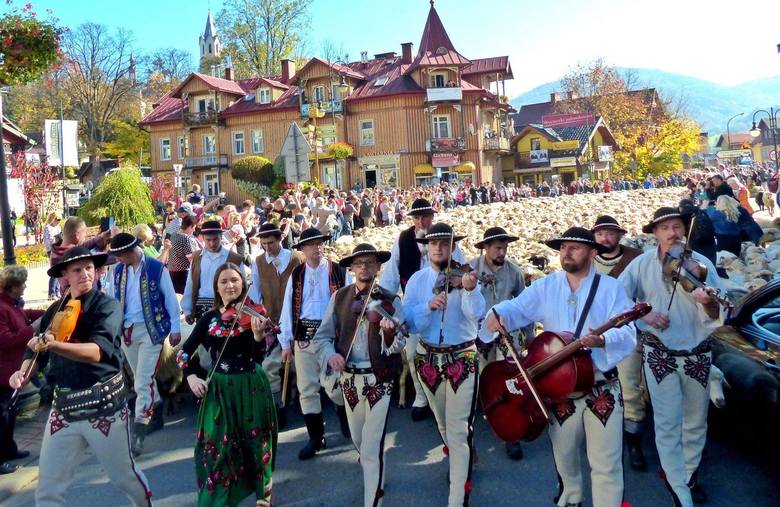

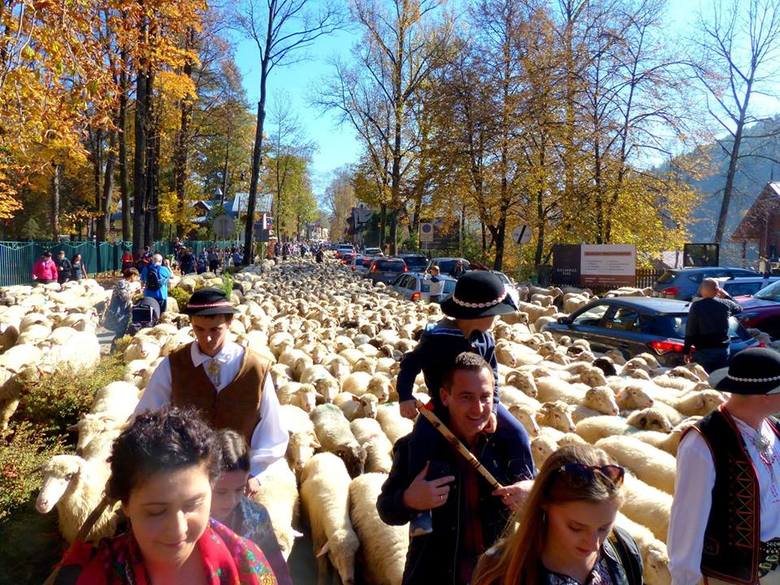
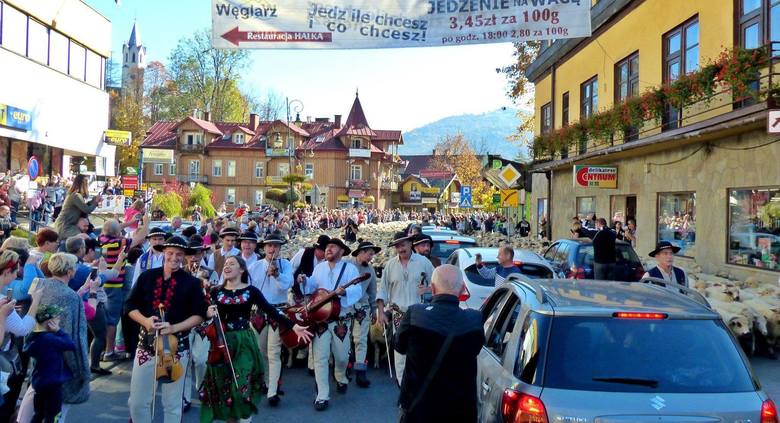
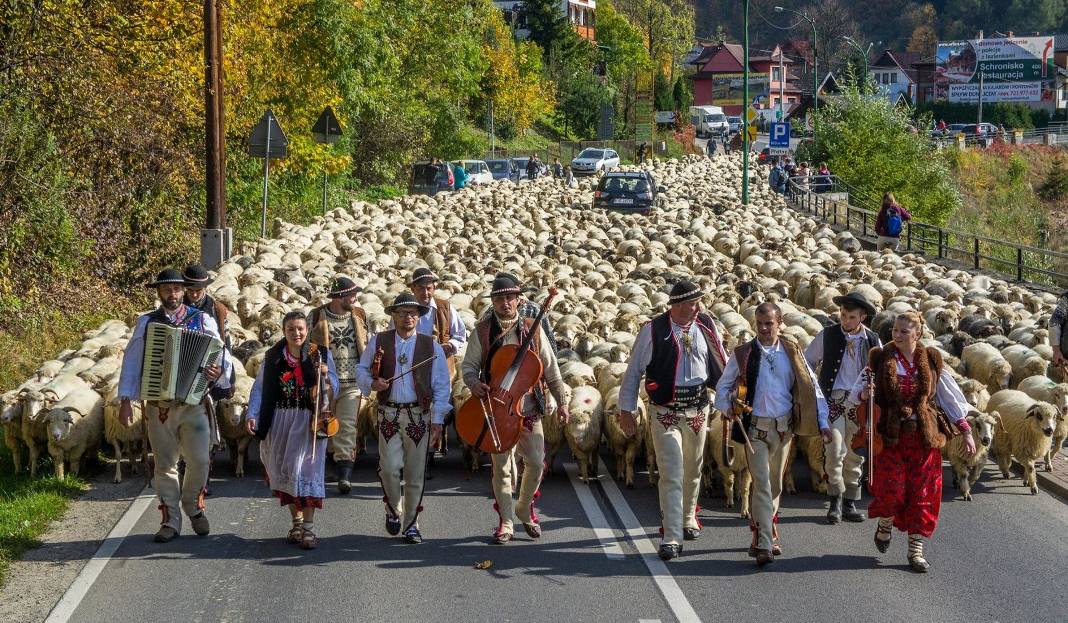

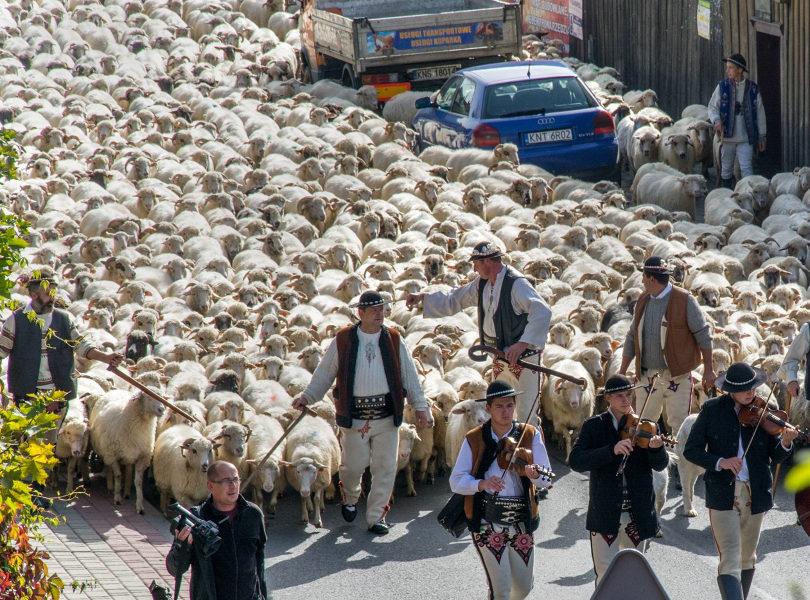
polandsite.proboards.com/post/35600/thread
Redyk articles on nice sites
www.lem.fm/the-end-of-ii-bieszczady-first-sheep-pasture-day-redyk-in-lemko-village-of-oslawica/
Redyk – it is a festival about herding flocks of sheep into the mountains, for pasturing (spring redyk) and bringing them back for winter (autumn redyk). The practice used to be common in the Carpathians and many customs accompanied it. Nowadays, it is necessary to remind the contemporary inhabitants of the Carpathians, who not shepherds any more, of it, and to restore it, at least in the form of a demonstrative event. During the autumn Bieszczady Redyk, the participants could take a bite of various types of cheese, visit a cheese farm and eat some local food. There were ethnobotanic workshops organized concerning herbs and other plants that grow on meadows, practical for use. Bow and arrow shooters from Sanok who attended the event presented the classical way of shooting. There were also quiz games, games and workshops for children organized, like making toys out of wool. Sounds of the trembita resonated all the time during the event and, as the final point, the Kapela Drewutnia ensemble performed.
linktopoland.com/en/shepherding-in-the-tatra-and-other-polish-mountains/
Pastoral customs, traditions, techniques and equipment came to the Polish mountains from the south. They were strongly influenced by Vlachs – nomadic people coming from the Balkan area, who in the early Middle Ages began centuries long pilgrimage to the north. Nomads assimilated with the inhabitants of the Carpathian range and taught them new skills. Pastoral way of life came upon a breeding ground – difficult natural conditions (harsh climate and poor soil) favoured more animal husbandry than cereal farming. Shepherding started to develop in the Tatra and other Polish mountains.
What did the traditional pastoral season look like?
Each owner wanted to send his sheep to the mountain pasture for summer. It would entail leaving the household for several months, what was impossible. Therefore the function of baca (the main shepherd) was established – a man to whom farmers entrusted their flocks for summer time grazing. Baca was choosing some helpers – younger shepherds and set off to the mountain pastures owned by the village. Walking to the pastures called redyk could last even several days, depending on how far from the mountains the village was located. On a pasturage shepherds lived in a wooden hut called bacówka. Apart from grazing they were protecting sheep from predators or getting lost and manufacturing products from sheep’s milk. The best known are three types of cheese – oscypek, bundz and bryndza. Grazing was terminated with autumn redyk – sheep descent from the mountains. It was a very solemn event, accompanied by singing and music. Then the main shepherd settled up with sheep owners and returned them their flocks. Children welcoming redyk were receiving little pieces of cheese in the shapes of animals. Many traditions and superstitions associated with the pastoral season come from a borderline between religion and pagan beliefs. They are subject of a number of ethnographic research nowadays.
What about shepherding in the Polish mountains today?
History of individual pastoral areas and its influence on contemporary sheep grazing caused diversification of shepherding in different regions of Poland. Idyllic view with sheep in the mountain pastures is not as common as it was in the past. Nevertheless we can still meet shepherds or even visit their huts while hiking on the mountain trails in Gorce, Beskids or Pieniny. In some areas (eg in the Bieszczady Mountains) the aim is to renew the tradition of pastoralism.
In the Tatra Mountains, where shepherding had been completely liquidated due to the nature conservation in the 70’s, it was decided to restore grazing. Decisive influence had cultural issues – perennial relationship between the highlanders and the Tatras and richness of traditions and customs as its effect. In 1981, shepherding returned in a form of so-called Cultural grazing of sheep and cattle in the Tatra Mountains. What does it mean? Under agreements with the Tatra National Park highlanders can graze sheep on some of the clearings. They must, however, obey several rules including speaking in a dialect, wearing the original highlander outfit, whether be assisted by traditional herding dogs – the Polish Tatra sheepdogs. The are many more requirements, but thanks to them we can learn more about old customs and try products prepared according to original recipes.
Extremely interesting event is the Carpathian Sheep Transhumance organized for the first time in 2013. It is an international project aimed at meeting people involved in shepherding across the whole Carpathian range linked together with an exchange of experiences. This is the traditional wander of shepherds and flocks through the mountain area of the Carpathian countries – Romania, Ukraine, Poland, Slovakia and Czech Republic. The trail is about 1,200 kilometers long (10-15 kilometers a day) and takes place between May and September. The wander is accompanied by various events.
Dusk, the day is slowly coming to the end. I hear the tinkling sound again… The sheep are coming back to the pen for the night.
avax.news/fact/Traditional_March_of_Highlanders_with_Flocks_of_Sheep_in_Poland.html
Traditional March of Highlanders with Flocks of Sheep in Poland
An owner holds his sheep that he found among a herd during "rozchod", which in local language means giving back sheep to owners, during autumn Redyk in Gron village, Tatra Mountains region of southern Poland October 7, 2015. (Photo by Kacper Pempel/Reuters)
An owner holds his sheep that he found among a herd during "rozchod", which in local language means giving back sheep to owners, during autumn Redyk in Gron village, Tatra Mountains region of southern Poland October 7, 2015. Redyk is a traditional, kilometres-long march of highlanders with flocks of sheep, which takes place twice a year: in the spring at the start of the grazing season, and in the autumn at season's end. Shepherds are paid by owners in sheep milk for looking after the flocks while they graze over the summer. The autumn redyk ends in festivities, as highlanders celebrate returning with the flocks from the grazing fields in the mountains. (Photo by Kacper Pempel/Reuters)
Shepherd herd sheep as they get home during autumn redyk in Gron, Tatra Mountains region of southern Poland, October 6, 2015. (Photo by Kacper Pempel/Reuters)
Owners look for their sheep among a herd during "rozchod", which in local language means giving back sheep to owners, during autumn Redyk in Gron village, Tatra Mountains region of southern Poland, October 7, 2015. (Photo by Kacper Pempel/Reuters)
Owners take out their sheep from a herd during "rozchod", which in local language means giving back sheep to owners, during autumn Redyk in Gron village, Tatra Mountains region of southern Poland, October 7, 2015. (Photo by Kacper Pempel/Reuters)
Shepherds walk with sheep through the village on their way home during autumn redyk in Gron, Tatra Mountains region of southern Poland, October 6, 2015. (Photo by Kacper Pempel/Reuters)
A car is trapped among sheep on their way home during autumn redyk in Gron village, Tatra Mountains region of southern Poland, October 6, 2015. (Photo by Kacper Pempel/Reuters)
Shepherds relax and eat pizzas as they take a break in their journey home with sheep during autumn redyk near Trybsz, Tatra Mountains region of southern Poland, October 6, 2015. (Photo by Kacper Pempel/Reuters)
Shepherds relax as they take a break in their journey home with sheep during autumn redyk near Trybsz, Tatra Mountains region of southern Poland, October 6, 2015. (Photo by Kacper Pempel/Reuters)
Shepherd Jan drinks vodka with others as they take a break in their journey home with sheep during autumn redyk near Trybsz, Tatra Mountains region of southern Poland, October 6, 2015. (Photo by Kacper Pempel/Reuters)
Around one thousand sheep are seen in the fog in the early morning during autumn redyk near Lapsze Wyzne village, Tatra Mountains region of southern Poland, October 6, 2015. (Photo by Kacper Pempel/Reuters)
Shepherds walk with sheep in the early morning during autumn redyk near Lapsze Wyzne village, Tatra Mountains region of southern Poland, October 6, 2015. (Photo by Kacper Pempel/Reuters)
Shepherds and sheep cross a bridge while on their way home during autumn redyk near Trybsz, Tatra Mountains region of southern Poland, October 6, 2015. (Photo by Kacper Pempel/Reuters)





















